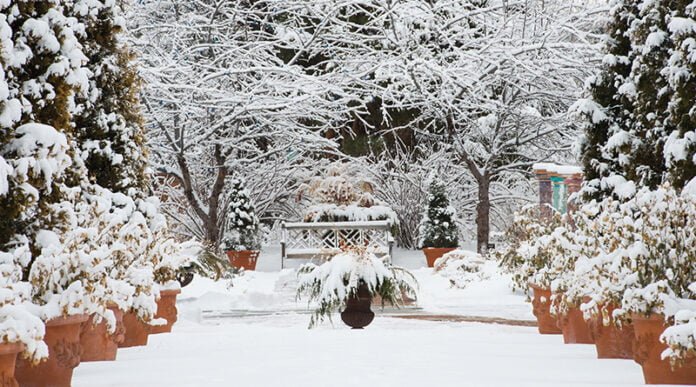A winter garden could be a dismal sight—bare trees, empty plots and snowdrifts replace the lush and verdant gardens of the spring and summer.
It could also be a blank canvas for landscape designers to create a unique space for clients hunkering down over the winter. Without attention-grabbing colors, the layout of the space and the structure of the plants therein become the main focal point—instead of color, think texture and shape.
“Obviously the whole concept of winter gardens is a little challenging in our climate,” Panayoti Kelaidis, senior curator and director of outreach for the Denver Botanic Gardens, said in an interview.
He noted that the landscape architects who have most successfully designed year-round gardens have done so by integrating shape, texture and contrast.
“What I find most pleasing is to combine different textures,” Kelaidis said. “If you have a finely textured plant, put one that’s a little more bold next to it and has a different color. Contrast is a powerful tool that people don’t use nearly enough.”
When selecting plants for a client’s garden, Kelaidis recommends that landscapers look at leaf color and foliage shape, and then fill in the rest of the landscape with color.
RELATED: Cold-hardy Color for Colorado Landscapes
Donn Vidosh, owner-operator of landscape design and maintenance firm Vidosh North in Petoskey, Michigan, believes that designers who don’t include winter interest in their designs aren’t fully serving their clients.
“Our winter, or let’s say our non-colorful or non-growing season, is almost as long as our spring-summer-fall colorful season. If we’re not planning and planting for winter interest,” he said, “we’re doing our customers a disservice.”
Petoskey is a resort community on the northwest coast of Michigan, and many of Vidosh’s clients only live in their homes for part of the year. Vacation homes are maintained a little bit differently from homes that are occupied year-round, which designers need to take into consideration when they’re planning with their clients.
For clients willing to brave the long winters, either in Michigan or in some of our mountain towns here in Colorado, designers need to envision how customers will get around their property in the winter when they’re deciding what to plant and where. Salt on sidewalks or pathways, and snow shoveled into borders, could negatively impact what’s planted nearby, Vidosh pointed out.
Even so, you can still find “a plant to work within the restrictions of the site,” he said.
Color, structure and scale
Despite what a lot of people think, Vidosh said, winter interest can include color. “It can be form. It can be structure. It can be movement. It can be a lot of different things, and it can come in a lot of different ways.”
He looks for plants with specific characteristics, like trees with exfoliating bark, berries or cherries, and a unique branch structure. He likes using crabapples for their color and form, but also because they begin attracting a lot of birds in late winter. Yellow- and red-twig dogwoods layered in front of a client’s evergreens provide a “nice winter color pop,” he said. Grasses are a good source of texture and color as well. Longer grasses need to be cut back to protect them from heavy snows, but more compact varieties, like blue fescue, do well and keep their color through the cold season.
Denver Botanic Gardens uses little bluestem grass, which turns a deep pinky red through the winter and grows to about a foot and half, Kelaidis said. “Some of our native grasses tend to be particularly nice,” he said. “There’s one called Blonde Ambition, which has become a hugely popular grass.” Blonde Ambition is a variety of Bouteloua gracilis, the state grass of Colorado, Kelaidis said, and “retains its substance over the winter.” The nice thing about grasses is that “they also wave a bit in the wind, so they add that extra bit of motion to a landscape.”
Vidosh is fond of ornamental grasses to bring movement and structure to a landscape, calling them a “three-season punch.”
“I can’t say enough good things about ornamental grasses,” he said. “We can find things to fill that spring void when our grasses aren’t up yet. … When you get those fresh snows, those lighter snows, and the snow is just kind of peaked up on the blooms and tassels of the ornamental grasses, that’s really a great look.”
Astilbe and upright varieties of Sedum are also valuable additions to a garden for winter interest, Vidosh said. Hydrangeas, which are “so popular right now for their summer interest,” he said, can be valuable in the cold months, too. In fact, “so many maintenance professionals or contractors make a huge mistake by cutting back their hydrangea in the fall,” he said. “Those dry blooms can be so appealing and attractive all the way throughout [the winter], and provide some great structure and interest in those off months.”
Panicled hydrangeas are a good choice, he recommends, like the Limelight or Little Lime varieties. “That foliage all falls off, but it’s almost like those dried blooms become its winter foliage.”
Evergreens, as always
The real workhorse for winter gardens, of course, is the evergreen. Conifers and broadleaf evergreens are important elements in a winter garden, according to Kelaidis. “For most people, conifers consist of Austrian pines and blue spruce and maybe a juniper; that’s what they think of. But in fact, there are hundreds of different kinds of conifers, and many of them are [available at a] much smaller scale that you can use in a home landscape.”
Alberta spruces, which can top out at 10 or 15 feet tall, are available in dwarf versions that grow to a much more manageable two or three feet, Kelaidis said.
Many of these plants take on a slightly different color as the temperature changes. Dwarf and miniature conifers come in shades of green, blue and yellow, he said. “You put them in a landscape and it provides color and structure in a garden.”
Bird nest spruces are another good option for home landscapes, he recommended. Creeping junipers are a small variety of juniper that provide ground cover and “look beautiful in the wintertime.”
Broadleaf evergreens are an underutilized plant in winter gardens, Kelaidis said. “You do see the evergreen Euonymus, which I’m not too crazy about,” he said. “They tend to burn in many winters, and look kind of ratty unless they’re in just the right spot.”
Some hardy viburnums keep their leaves very late, he continued, like the Alleghany, which “takes on a lovely reddish color, and has big, broad leaves that last much of the winter.” Manzanitas are a “tremendously unsung group of plants,” he said. These evergreen shrubs come from Western Colorado and produce buds throughout winter. The Chieftain manzanita develops reddish purple bark as it matures.
Kelaidis said Denver Botanic Gardens has introduced three or four varieties of manzanita in its Plant Select program. “They’re gorgeous all winter. They have these beautiful army green leaves and a very graceful habit,” he said.
Plant Select is a collaboration between the Gardens, Colorado State University and professional horticulturists to identify and distribute plants that are ideally suited to landscapes and gardens in Colorado.
Mountain mahogany is a dark evergreen that can be used as a hedge that Kelaidis calls “the most beautiful hedge in Denver.” Unlike privets, it doesn’t need to be hedged all the time. It can grow to about 30 feet, and is deer-resistant.
Unfortunately, Kelaidis said, it “has never been championed by any program so people don’t know about it, but it’s one of the great small trees or shrubs for home landscapes. It’s gorgeous year-round—beautiful trunk, beautiful foliage. I’d say that’s the champion. If you want to have a beautiful garden, put in a few of those.”
Winterberry and holly might be obvious choices for a winter garden, but growing them in Colorado can be difficult. Designers whose customers have their hearts set on these Christmas favorites should consider where in the space it will be planted.
“Just because your house is in a [USDA] zone, that doesn’t mean that every area of that site is in that zone,” Vidosh explained. “On a site, there are all different types of exposures and climates.” One side of a client’s house may get hit hard with winter wind and sun that can lead to bark or sap problems, while the opposite is shaded and sheltered from the wind.
“It’s important for contractors and designers to not completely give up on a plant just because it didn’t work for them one time,” he continued.
Evergreens are “no-brainer” plants for winter garden design; Vidosh said they are the “major structural part of the winter design aspect, and everything else is the window dressing” around them.
Where (and when) flowers bloom
While many flowering plants have to be cut back or covered through the winter, there are some blooming options for the cold season.
Hellebores have been hybridized so there are hundreds of options for landscapers, according to Kelaidis. They have dark evergreen leaves, and are a tough, drought-tolerant option for flowering plants in winter. Kelaidis favors Christmas roses. “They’re perfect for that dry, shady garden that everybody has complaints about,” he said. “I have a bunch of them in my garden. I just love them. They’ll start blooming … and some of them will bloom right through the winter.”
Winter heather “loves it here,” he continued. “Most heathers need to have that acid soil like they have at the coast, but this one just grows on plain old alkaline clay and sand that we have here.”
Winter heather isn’t as widely available as other varieties, but can be ordered online. It’s the hardiest of the heathers, and often starts blooming in January. “It’s fantastic in February and March when you need color,” Kelaidis said.
A lot of brightly colored flowers make for a showy garden, but Kelaidis pointed out that people notice pleasing patterns. “That ultimately is what garden design is about: creating textures and appeal. You can have a formal garden that does it with formal elements, or you can have a naturalistic garden.”









This is a timely article. I would have liked to see pictures of the winter gardens they have created. It’s allows easy to talk design but actually installing and maintaining is the difficult and interesting part.
The article with additional photos can be found in our print edition of Colorado Patio & Landscape: https://www.bluetoad.com/publication/?i=473310#{%22issue_id%22:473310,%22page%22:16}
Excellent post on Colorado’s long, harsh winters! We’re a new landscaping company in the state and we’re always trying to incorporate every season into our work. Thanks for your insights!
Thanks for the insight, we’re starting a new business in Ohio which should experience the same severity of winters as Colorado. Looking to integrate your advice into our work, thank you.